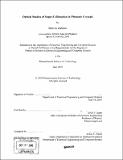| dc.contributor.advisor | Erich P. Ippen. | en_US |
| dc.contributor.author | Dahlem, Marcus | en_US |
| dc.contributor.other | Massachusetts Institute of Technology. Dept. of Electrical Engineering and Computer Science. | en_US |
| dc.date.accessioned | 2006-11-07T17:18:21Z | |
| dc.date.available | 2006-11-07T17:18:21Z | |
| dc.date.copyright | 2005 | en_US |
| dc.date.issued | 2005 | en_US |
| dc.identifier.uri | http://hdl.handle.net/1721.1/34677 | |
| dc.description | Thesis (S.M.)--Massachusetts Institute of Technology, Dept. of Electrical Engineering and Computer Science, 2005. | en_US |
| dc.description | Includes bibliographical references (p. [121]-125). | en_US |
| dc.description.abstract | Recent developments in material science and engineering have made possible the fabrication of photonic crystals for optical wavelengths. These periodic structures of alternating high-to-low index of refraction materials allow the observation of peculiar effects, in particular, the propagation of optical beams without spatial spreading. This effect, called super-collimation (also known as self-collimation), allows diffraction-free propagation of micron-sized beams over centimeter-scale distances. This linear effect is a natural result of the unique dispersive properties of photonic crystals. In this thesis, these dispersive properties are studied in a two-dimensional photonic crystal slab. Both qualitative and quantitative descriptions are presented. The beam propagation method was used to simulate the evolution of a Gaussian beam inside such structures. The wavelength dependence of the super-collimation effect was studied, and it was observed that the optimum wavelength for this device was around 1500 nm. A precise contact-mode near-field optical microscopy technique was used to obtain high-resolution images of the beam profile at different positions along the photonic crystal, and showed that a 2 [micro]m beam width was conserved over 3 mm. In addition, high-resolution confocal measurements confirmed the size of the beam after 5 mm of propagation. | en_US |
| dc.description.abstract | (cont.) The figure of merit associated with the super-collimation effect is defined by the number of diffraction lengths over which the beam stays collimated. The diffraction length is the distance in which a beam will broaden to 2¹ʹ² of its initial width. Previous experimental studies showed figures of merit smaller than 6; the results of this experiment show figures of merit as high as 376, which correspond to more than 14200 lattice constants. Preliminary results were obtained with an 8 mm sample that could achieve a figure of merit of 601. | en_US |
| dc.description.statementofresponsibility | by Marcus Dahlem. | en_US |
| dc.format.extent | 125 p. | en_US |
| dc.format.extent | 4608659 bytes | |
| dc.format.extent | 4613886 bytes | |
| dc.format.mimetype | application/pdf | |
| dc.format.mimetype | application/pdf | |
| dc.language.iso | eng | en_US |
| dc.publisher | Massachusetts Institute of Technology | en_US |
| dc.rights | M.I.T. theses are protected by copyright. They may be viewed from this source for any purpose, but reproduction or distribution in any format is prohibited without written permission. See provided URL for inquiries about permission. | en_US |
| dc.rights.uri | http://dspace.mit.edu/handle/1721.1/7582 | |
| dc.subject | Electrical Engineering and Computer Science. | en_US |
| dc.title | Optical studies of super-collimation in photonic crystals | en_US |
| dc.type | Thesis | en_US |
| dc.description.degree | S.M. | en_US |
| dc.contributor.department | Massachusetts Institute of Technology. Department of Electrical Engineering and Computer Science | |
| dc.identifier.oclc | 67617271 | en_US |
